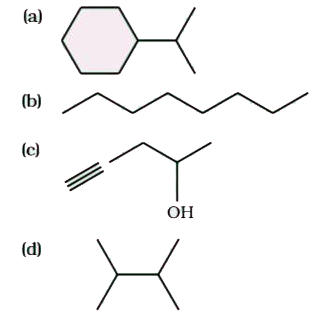Complete Solutions to PROBLEM SOLUTION of chapter ORGANIC CHEMISTRY - SOME BASIC PRINCIPLES AND TECHNIQUES of Class 11 book with complete answers and questions
| Class 11 | CHEMISTRY |
| Chapter | ORGANIC CHEMISTRY - SOME BASIC PRINCIPLES AND TECHNIQUES |
| NCERT TELUGU | PROBLEM SOLUTION |
| Number Of Questions | 24 |
| Academic Year | 2023-24 |
How many `σ` and `π` bonds are present in each of the following molecules?
(a) `HC≡C CH=CHCH_(3)` (b) `CH_(2)=C=CHCH_(3)`
View SolutionWhat is the type of hybridisation of each carbon in the following compounds?
(a) `CH_(3)Cl`, (b) `(CH_(3))_(2)CO`, (c ) `CH_(3)CN`,
(d) `HCONH_(2)`, (e) `CH_(3)CH=CHCN`
View SolutionWrite the state of hybridisation of carbon in the following compounds and shapes of each of the molecules.
(a) `H_(2)C=O`, (b) `CH_(3)F`, (c ) `HC-=N`.
View SolutionExpand each of the following condensed formulas into their complete structural formulas.
(a) `CH_(3)CH_(2)COCH_(2)CH_(3)`
(b) `CH_(3)CH=CH(CH_(2))_(3)CH_(3)`
View SolutionFor each of the following compounds, write a condensed formula and also their bond-line formula.
(a) `HOCH_(2)CH_(2)CH_(2)CH(CH_(3))CH(CH_(3))CH_(3)`
(b) `N-=C-overset(OH)overset("| ")(CH)-C-=N`
View SolutionExpand each of the following bond-line formulas to show all the atoms including carbon and hydrogen
(a)
View SolutionStructures and IUPAC names of some hydrocarbons are given below. Explain why the names given in the parentheses are incorrect.
(a) `CH_(3)-underset(CH_(3))underset("| ")(CH)-CH_(2)-CH_(2)-underset(CH_(3))underset("| ")(CH)-underset(CH_(3))underset("| ")(CH)-CH_(2)-CH_(3)`
2,5,6- Trimethyloctane
[and not 3,4,6-Trimethyloctane]
(b) `CH_(3)-CH_(2)-underset(CH_(2)CH_(3))underset("| ")(CH-CH_(2))-underset(CH_(3))underset("| ")(CH)-CH_(2)-CH_(3)`
3-Ethyl-5-methylheptane
[and not 5-Ethyl-3-methylheptane]
View SolutionWrite the IUPAC names of the compounds i-iv from their given structures.
(i) `overset(1)(C)H_(3)-overset(2)(C)H_(2)-underset(OH)underset("| ")overset("3 ")(CH)-overset(4)(C)H_(2)-overset(5)(C)H_(2)-underset(CH_(3))underset("| ")overset("6 ")(CH)-overset(7)(C)H_(2)-overset(8)(C)H_(3)`
(ii) `underset(6)(C)H_(3)-underset(5)(C)H_(2)-underset(4)overset(O)overset(||)(C)-underset(3)(C)H_(2)-underset(2)overset(O)overset(||)(C)-underset(1)(C)H_(3)`
(iii) `underset(6)(C)H_(3)-underset(5)overset(O)overset(||)(C)-underset(4)(C)H_(2)-underset(3)(C)H_(2)-underset(2)(C)H_(2)-underset(1)(C)OOH`
(iv) `underset(6)(C)H-=underset(5)(C)-underset(4)(C)H=underset(3)(C)H-underset(2)(C)H=underset(1)(C)H_(2)`
View SolutionDerive the structure of (i) 2-Chlorohexane, (ii) Pent-4-en-2-ol, (iii) 3- Nitrocyclohexene, (iv) Cyclohex-2-en-1-ol, (v) 6-Hydroxy- heptanal.
View SolutionWrite the structural formula of:
(a) o-Ethylanisole, (b) p-Nitroaniline,
(c) 2,3 -Dibromo -1 - phenylpentane,
(d) 4-Ethyl-1-fluoro-2-nitrobenzene.
View SolutionUsing curved-arrow notation, show the formation of reactive intermediates when the following covalent bonds undergo heterolytic cleavage.
(a) `CH_(3)-SCH_(3)`, (b) `CH_(3)-CN`, (c ) `CH_(3)-Cu`
View SolutionGiving justification, categorise the following moelcules/ions as nucleophile or electrophile:
`HS^(-),BF_(3),C_(2)H_(5)O^(-),(CH_(3))_(3)N`:
`Coverset(+)(l),CH_(3)-overset(+)(C)=O,H_(2)Nbar:,overset(+)(N)O_(2)`
View SolutionIdentify electrophilic centre in the following: `CH_(3)CH=O,CH_(3)CN,CH_(3)I`.
View SolutionWhich bond is more polar in the following pairs of molecules: (a) `H_(3)C-H, H_(3)C-Br`
(b) `H_(3)C-NH_(2), H_(3)C-OH` (c ) `H_(3)C-OH`, `H_(3)C-SH`
View SolutionIn which C–C bond of `CH_(3)CH_(2)CH_(2)Br`, the inductive effect is expected to be the least?
View SolutionWrite resonance structures of `CH_(3)COO^(–)` and show the movement of electrons by curved arrows.
View SolutionWrite resonance structures of `CH_(2)=CH–CHO`. Indicate relative stability of the contributing structures.
View SolutionExplain why the following two structures, I and II cannot be the major contributors to the real structure of `CH_(3)COOCH_(3)`.

View SolutionExplain why `(CH_(3))_(3)overset(+)(C )` is more stable than `CH_(3)overset(+)(C )H_(2) and overset(+)(C )H_(3)` is the least stable cation.
View SolutionOn complete combustion, 0.246 g of an organic compound gave 0.198g of carbon dioxide and 0.1014g of water. Determine the percentage composition of carbon and hydrogen in the compound.
View SolutionIn Dumas’ method for estimation of nitrogen, 0.3g of an organic compound gave 50mL of nitrogen collected at 300K temperature and 715mm pressure. Calculate the percentage composition of nitrogen in the compound. (Aqueous tension at 300K=15 mm)
View SolutionDuring estimation of nitrogen present in an organic compound by Kjeldahl’s method, the ammonia evolved from 0.5 g of the compound in Kjeldahl’s estimation of nitrogen, neutralized 10 mL of `1 M H_(2)SO_(4)`. Find out the percentage of nitrogen in the compound.
View SolutionIn Carius method of estimation of halogen, 0.15 g of an organic compound gave 0.12 g of AgBr. Find out the percentage of bromine in the compound.
View SolutionIn sulphur estimation, 0.157 g of an organic compound gave 0.4813 g of barium sulphate. What is the percentage of sulphur in the compound?
View Solution
PROBLEM SOLUTION questions and complete solutions for chapter ORGANIC CHEMISTRY - SOME BASIC PRINCIPLES AND TECHNIQUES of NCERT CHEMISTRY(TELUGU) of Class 11